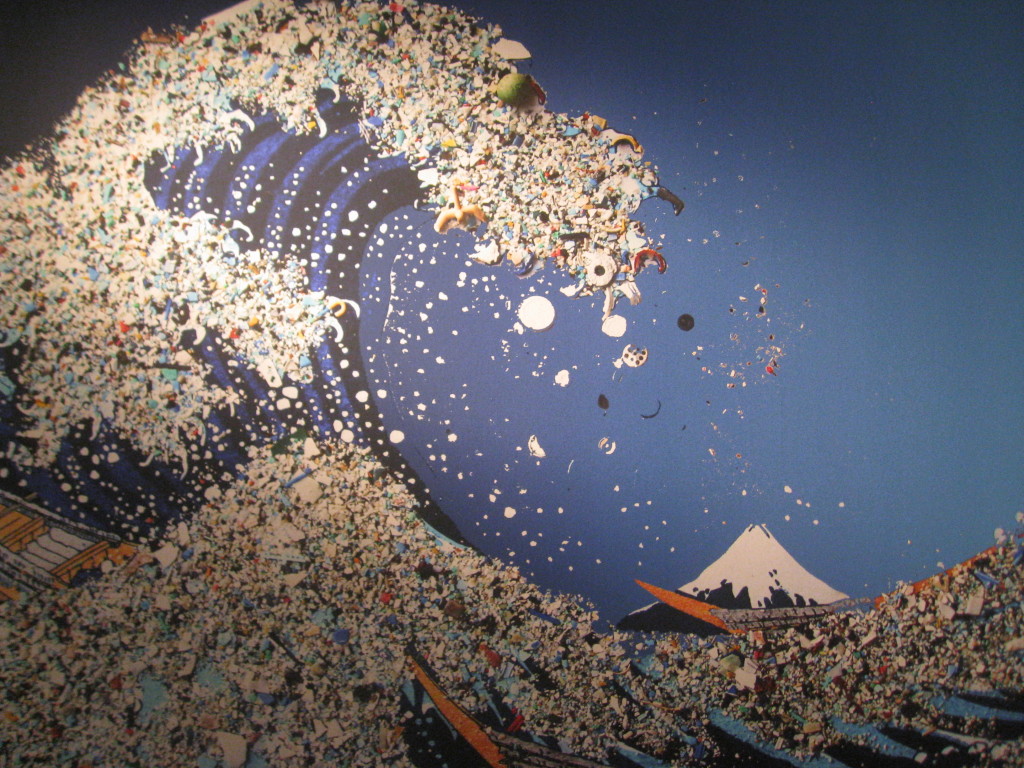Dear Sophea,
I’m thinking about trash.
I’ve just come in from the garden. It’s a little empty lot, that was once full of nothing but trash. Tires and broken windows and rubble and plastic. 15 years ago, I cleaned it out and filled it with sunflowers with some local kids. Now, 15 years later, it’s got roses and lilacs, tulips and lilies… and an awful lot of trash. Deep rooted trash. Bottlecaps. Condoms. Batteries. Glass. Plastic wrappers from ice-pops. Plastic bags of potato chips. Where does it all come from?
So, like a baleen whale combing the sea-water for krill, I am just scooping up and devouring all of the topsoil and running it through screens, separating rubble and gravel, from roots, from plastic and other trash.

Tsunami of Trash, after Hokusai, anonymous From http://galleryhip.com/great-pacific-garbage-patch-gyre.html
The new issue of The New Inquiry is about trash.
In a real, material sense, capitalism doesn’t produce goods nearly so much as it produces trash.
Images of this garbage system’s extremes proliferate: children’s fingers picking through electronic waste in search of rare earth, an oceanic plastic-bag gyre five miles wide, a bulldozer reducing a slum into rubble, a lake of excreted industrial chemicals transforming acre upon acre into black sludge. The circulation and consumption of these images—as well as the outrage they are designed to create—are themselves the products of generalized disposability and obsolescence.
But if this points to one of capitalism’s great innovations—that waste creation is not only an acceptable but a desirable method of profit production—capital’s defenders have always pretended exactly the opposite, extolling efficiency and precision, telling the poor “waste not, want not.” The capitalist world is built on a giant mound of garbage… –
“The circulation and consumption of these images…” leads me inevitably to think about these fairs. Last week in NYC, it was Frieze and NADA (and there were two more!)
They’re such an exciting cancer, aren’t they? Full of cash, cosmetics, gloss… but also producing so much CO2 and garbage, with their shipping containers, FedEx boxes, flights, bars. I spent barely 10 minutes at the outdoor bar of NADA and was amazed by the dancing of the army of fat janitors collecting trash non-stop from the table-tops of the skinny people. (Tangent for another post: Has racism been replaced by sizeism?)
Jamie Sterns, a columnist for Art News, described the Art Fairs this week as “slaughterhouses“:
Why do I think art fairs are slaughterhouses? Because they are holding pens in which art gets chopped and bought. There is a dehumanizing functionality to it. The processes, the product, and the roles played by each participant have the air of necessity, making the larger horror of it rationalized and/or hidden. How is this so?
You’ll have to read his article to get the rest of his description. But let’s agree that, like slaughterhouses, Art Fairs produce a great deal of waste, to be rendered or dumped. If we can agree on that, I wonder: Do we need this Global Art thing, anymore? I’m not talking about the glitz and the glamor. It’s shameful, to be sure, and an expression of the growing rifts between the 1% and everyone else… but hey, I enjoy it as much as every other broke artist or writer who loves an open bar. No, you know I love that stuff. No one needs it, but what has art got to do with need?
But, I’m talking about the carbon. The plastic and the Co2. The flights. The speed. The shipping containers. Does anyone even want it? Can our planet really afford it? Doesn’t the climate crisis demand a new dematerialization of the object of art? (Hand in hand with a renewal of artistic traditions of city building, architecture, memorial, placemaking? That’s for another blog post.)
I found one such solvent, right there in the heart of NADA, eroding the walls of the other booths. It was called Daata Editions.
Daata Editions Trailer 2 from Daata Editions on Vimeo.
Daata Editions is an online platform for the sale of artist commissioned video, sound and web art editions. This new and innovative way to collect art is designed specifically to be a native platform to a new generation of artists who are working with moving image and sound.
They have sidestepped (or avoided) what I call “the Container Problem” of sound art and there is no thing that they need to valorize in order to make an exchange. What they sell is a data file, along with a certification that holds some real and fictional rights for public presentation or transfer of the work. It’s very interesting to me, and reminds me of our conversation back in Helsinki when we first met about the importance of new models of patronage for sound art, or what I referred to then as “many kinds of sunlight.” (I’ll try to dig that up and post to the blog.)
Check em out! I would love to know what you think.
very best wishes
Lex
18 May 2015
Albany, New York
ps: On other notes, and thinking of other, slower and more intimate and intense models of world travel, our friend Jodi, who I also met on that first trip to Helsinki back in 2004, is working on a memoir called I’ve heard the Bridges Singing. It’ll be an ebook. No added weight.


You must be logged in to post a comment.